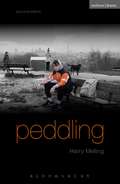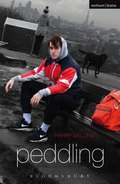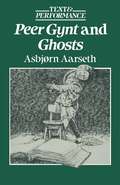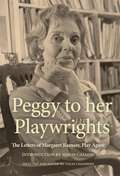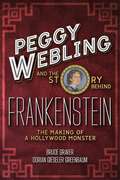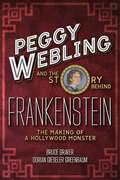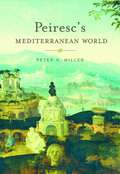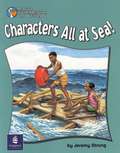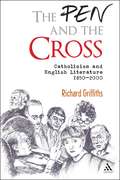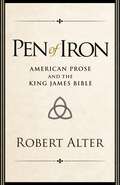- Table View
- List View
peddling (Modern Plays)
by Harry Mellingif I was gold almighty himself,and destroyed this first attempt at life.what would my second version be?. . . a dead end of endless possibility.A pedlar boy wakes up in a field somewhere in London, surrounded by the remnants of the night before. With no memory of how he has come to be there, he knows he must go back to the start in order to understand it all. His attempts to retrace events from the previous days lead him on a haunting journey where everything comes into question: his life, his world, his future.peddling is Harry Melling's remarkable debut play following a day in the life of a door-to-door salesman as he battles difficult questions and attempts to come to terms with the resulting truths.peddling received its world premiere at Hightide Festival on 10 April 2014, performed by Harry Melling, before transferring to 59E59 Theatre, NY, for a four-week run. It was revived in 2015 by HighTide at the Arcola Theatre, London.
peddling: Ditch; Peddling; The Big Meal; Lampedusa (Modern Plays)
by Harry MellingA boy wakes up in a field somewhere in London. He's a door-to-door salesman: a pedlar boy. An encounter with an old acquaintance sends him into a frenzied questioning of everything: his life, his world, where he's coming from and where he's going to.peddling received its world premiere at Hightide Festival on 10 April 2014, performed by Harry Melling, before transferring to 59E59 Theatre, NY, for a four-week run.
peddling: Ditch; Peddling; The Big Meal; Lampedusa (Modern Plays)
by Harry Mellingif I was gold almighty himself,and destroyed this first attempt at life.what would my second version be?. . . a dead end of endless possibility.A pedlar boy wakes up in a field somewhere in London, surrounded by the remnants of the night before. With no memory of how he has come to be there, he knows he must go back to the start in order to understand it all. His attempts to retrace events from the previous days lead him on a haunting journey where everything comes into question: his life, his world, his future.peddling is Harry Melling's remarkable debut play following a day in the life of a door-to-door salesman as he battles difficult questions and attempts to come to terms with the resulting truths.peddling received its world premiere at Hightide Festival on 10 April 2014, performed by Harry Melling, before transferring to 59E59 Theatre, NY, for a four-week run. It was revived in 2015 by HighTide at the Arcola Theatre, London.
Pedro Calderón de la Barca: El purgatorio de San Patricio (Hispanic Studies Textual Research and Criticism (TRAC))
by José Ruano de la HazaThis is a critical edition of this play by Calderon, based primarily on the text of the "primera parte" of 1635, but also taking into account three other 17th-century printed editions and a scribal manuscript in the Biblioteca Nacional of Madrid. The relationship between these texts is discussed in the introduction, which also deals with the source of the legend of Saint Patrick's purgatory. The introduction also considers the literary sources of the play, notably "Vida y Purgatorio de San Patricio", the date of composition, versification, and the ways in which the the play has been staged.
Peeling the Onion: A Memoir
by Günter GrassPeeling the Onion is a searingly honest account of Grass' modest upbringing in Danzig, his time as a boy soldier fighting the Russians, and the writing of his masterpiece, The Tin Drum, in Paris.It is a remarkable autobiography and, without question, one of Günter Grass' finest works.By the Nobel Prize-winning author of The Tin Drum.
Peer Assessment in Writing Instruction (Elements in Language Teaching)
by null Shulin YuThis Element traces the evolution of peer assessment in writing instruction and illustrates how peer assessment can be used to promote the teaching and learning of writing in various sociocultural and educational contexts. Specifically, this Element aims to present a critical discussion of the major themes and research findings in the existing studies on peer assessment regarding the three assessment paradigms (assessment of, for, and as learning), and to identify whether and how peer assessment has served the purposes of assessment of, for, and as learning, respectively in writing instruction. This Element highlights the contextual factors that shape the effect of peer assessment in writing instruction and concludes with directions for future research and implications regarding how peer assessment can be successfully used to improve students' writing development.
Peer Gynt and Ghosts: Text and Performance (Text and Performance)
by Asbjorn AarsethA study of two of Henrik Ibsen's most impressive and frequently- performed dramatic texts, the dramatic poem Peer Gynt and the concentrated prose play Ghosts, whose appearance caused an uproar when first performed. In the first half of the book, the author pays particular attention to the imagery patterns of Ibsen's language; Peer Gynt is considered in its cultural context, and Ghosts with reference to Ibsen's concept of drama. Recent productions of both plays are considered in detail, including the Young Vic production of Ghosts in 1986.
Peer Interaction and Second Language Learning (Second Language Acquisition Research Series)
by Jenefer Philp Rebecca Adams Noriko IwashitaPeer Interaction and Second Language Learning synthesizes the existing body of research on the role of peer interaction in second language learning in one comprehensive volume. In spite of the many hours that language learners spend interacting with peers in the classroom, there is a tendency to evaluate the usefulness of this time by comparison to whole class interaction with the teacher. Yet teachers are teachers and peers are peers – as partners in interaction, they are likely to offer very different kinds of learning opportunities. This book encourages researchers and instructors alike to take a new look at the potential of peer interaction to foster second language development. Acknowledging the context of peer interaction as highly dynamic and complex, the book considers the strengths and limitations of peer work from a range of theoretical perspectives. In doing so, Peer Interaction and Second Language Learning clarifies features of effective peer interaction for second language learning across a range of educational contexts, age spans, proficiency levels, and classroom tasks and settings.
Peer Interaction and Second Language Learning (Second Language Acquisition Research Series)
by Jenefer Philp Rebecca Adams Noriko IwashitaPeer Interaction and Second Language Learning synthesizes the existing body of research on the role of peer interaction in second language learning in one comprehensive volume. In spite of the many hours that language learners spend interacting with peers in the classroom, there is a tendency to evaluate the usefulness of this time by comparison to whole class interaction with the teacher. Yet teachers are teachers and peers are peers – as partners in interaction, they are likely to offer very different kinds of learning opportunities. This book encourages researchers and instructors alike to take a new look at the potential of peer interaction to foster second language development. Acknowledging the context of peer interaction as highly dynamic and complex, the book considers the strengths and limitations of peer work from a range of theoretical perspectives. In doing so, Peer Interaction and Second Language Learning clarifies features of effective peer interaction for second language learning across a range of educational contexts, age spans, proficiency levels, and classroom tasks and settings.
Peer Interactions in New Content and Language Integrated Settings (Educational Linguistics #24)
by Nathan J. DevosTrade schools, universities, and programs for international students have begun to experiment with Content and Language Integrated Learning (CLIL) as a viable pedagogy for instruction, as the pedagogy of CLIL increasingly gains recognition as a practical form of language and content education in Europe and beyond, and its application in instructional settings becomes more diverse. Corresponding with CLIL’s growth, this book focuses on foreign language use during peer interactions in a new CLIL setting. It particularly concentrates on how to conduct research when the focus is on learner interactions. The theoretical background, research methods, and research instruments are explained in a brief and understandable manner. This book is intended for those interested in CLIL and peer interactions and includes a framework and ideas for investigating new CLIL contexts in a practical manner allowing undergraduate and graduate students to conduct their own research in these settings.
Peer Response in Second Language Writing Classrooms, Second Edition (The Michigan Series on Teaching Multilingual Writers)
by Jette Hansen Edwards Jun LiuSince the publication of the first edition in 2002, there have been two major developments in L2 writing and peer response teaching and research. The first is the increased interest in CALL and computer-mediated communication (CMC) for L2 pedagogy; the second is the accessibility and viability of research on L2 peer response from all over the world. Both developments are thoroughly addressed in this new edition. Now that classes are as likely to be online as held in physical classrooms and now that a new generation of digital natives can routinely read and respond to what others write via laptops, tablets, and phones, peer response as pedagogical practice is not just more easily implemented, but it is more likely to feel natural to L2 learners. The Second Edition is a highly accessible guide to how the world is using peer response and serves as a motivator and facilitator for those who want to try it for the first time or want to increase the effectiveness of the activities—whether via CMC or not. The volume includes 11 forms useful in training students to provide good peer feedback, including a final checklist to ensure teachers have taken all the necessary steps to achieve a successful peer feedback activity.
Peggy to her Playwrights: The Letters of Margaret Ramsay, Play Agent
by Colin Chambers Peggy RamsayPeggy Ramsay (1908-1991) was the foremost play agent of her time. Her list of clients shows her to have been at the centre of British playwriting for several generations from the late 1950s on.To her remarkable array of clients, her letter writing was notorious, marked by searing candour, both a wondrous motivation and an unforgiving scrutiny to be feared.'Peggy judged by the most exalted standards and lashed her writers when they failed to meet them. Her force of personality made her well-nigh irresistible. The letters she wrote to her writers and to producers are extraordinary documents, filled with all these qualities, and indiscreet, blasphemous and saucy to boot.’ – Simon Callow
Peggy Webling and the Story behind Frankenstein: The Making of a Hollywood Monster
by Peggy Webling Dorian Gieseler Greenbaum Professor Bruce GraverThe 1931 Universal Pictures film adaptation of Frankenstein directed by James Whale and starring Boris Karloff as the now iconic Monster claims in its credits to be 'Adapted from the play by Peggy Webling'. Webling's play sought to humanize the creature, was the first stage adaptation to position Frankenstein and his creation as doppelgängers, and offered a feminist perspective on scientific efforts to create life without women, ideas that suffuse today's perceptions of Frankenstein's monster. The original play script exists in several different versions, only two of which have ever been consulted by scholars; no version has ever been published. Nor have scholars had access to Webling's private papers and correspondence, preserved in a family archive, so that the evolution of Frankenstein from book to stage to screen has never been fully charted. In Peggy Webling and the Story behind Frankenstein, Dorian Gieseler Greenbaum (Webling's great grandniece) and Bruce Graver present the full texts of Webling's unpublished play for the first time. A vital critical edition, this book includes: - the 1927 British Library Frankenstein script used for the first production of the play in Preston, Lancashire - the 1928 Frankenstein script in the Library of Congress, used for productions in UK provincial theatres from autumn 1928 till 1930 - the 1930 Frankenstein Prompt Script for the London production and later provincial performances, held by the Westminster Archive, London - Webling's private correspondence including negotiations with theatre managers and Universal Pictures, family letters about the writing and production process, and selected contracts - Text of the chapter 'Frankenstein' from Webling's unpublished literary memoir, The Story of a Pen for additional context - Biography of Webling that bears directly on the sensibilities and skills she brought to the writing of her play - History of how the play came to be written and produced - The relationship of Webling's play to earlier stage and film adaptations - An exploration of playwright and screenwriter John L. Balderston's changes to Webling's play and Whale's borrowings from it in the 1931 film Offering a new perspective on the genesis of the Frankenstein movie, this critical exploration makes available a unique and necessary 'missing link' in the novel's otherwise well-documented transmedia cultural history.
Peggy Webling and the Story behind Frankenstein: The Making of a Hollywood Monster
by Peggy Webling Dorian Gieseler Greenbaum Professor Bruce GraverThe 1931 Universal Pictures film adaptation of Frankenstein directed by James Whale and starring Boris Karloff as the now iconic Monster claims in its credits to be 'Adapted from the play by Peggy Webling'. Webling's play sought to humanize the creature, was the first stage adaptation to position Frankenstein and his creation as doppelgängers, and offered a feminist perspective on scientific efforts to create life without women, ideas that suffuse today's perceptions of Frankenstein's monster. The original play script exists in several different versions, only two of which have ever been consulted by scholars; no version has ever been published. Nor have scholars had access to Webling's private papers and correspondence, preserved in a family archive, so that the evolution of Frankenstein from book to stage to screen has never been fully charted. In Peggy Webling and the Story behind Frankenstein, Dorian Gieseler Greenbaum (Webling's great grandniece) and Bruce Graver present the full texts of Webling's unpublished play for the first time. A vital critical edition, this book includes: - the 1927 British Library Frankenstein script used for the first production of the play in Preston, Lancashire - the 1928 Frankenstein script in the Library of Congress, used for productions in UK provincial theatres from autumn 1928 till 1930 - the 1930 Frankenstein Prompt Script for the London production and later provincial performances, held by the Westminster Archive, London - Webling's private correspondence including negotiations with theatre managers and Universal Pictures, family letters about the writing and production process, and selected contracts - Text of the chapter 'Frankenstein' from Webling's unpublished literary memoir, The Story of a Pen for additional context - Biography of Webling that bears directly on the sensibilities and skills she brought to the writing of her play - History of how the play came to be written and produced - The relationship of Webling's play to earlier stage and film adaptations - An exploration of playwright and screenwriter John L. Balderston's changes to Webling's play and Whale's borrowings from it in the 1931 film Offering a new perspective on the genesis of the Frankenstein movie, this critical exploration makes available a unique and necessary 'missing link' in the novel's otherwise well-documented transmedia cultural history.
Peirce’s Speculative Grammar: Logic as Semiotics (Routledge Studies in American Philosophy)
by Francesco BellucciPeirce’s Speculative Grammar: Logic as Semiotics offers a comprehensive, philologically accurate, and exegetically ambitious developmental account of Peirce’s theory of speculative grammar. The book traces the evolution of Peirce’s grammatical writings from his early research on the classification of arguments in the 1860s up to the complex semiotic taxonomies elaborated in the first decade of the twentieth century. It will be of interest to academic specialists working on Peirce, the history of American philosophy and pragmatism, the philosophy of language, the history of logic, and semiotics.
Peirce’s Speculative Grammar: Logic as Semiotics (Routledge Studies in American Philosophy)
by Francesco BellucciPeirce’s Speculative Grammar: Logic as Semiotics offers a comprehensive, philologically accurate, and exegetically ambitious developmental account of Peirce’s theory of speculative grammar. The book traces the evolution of Peirce’s grammatical writings from his early research on the classification of arguments in the 1860s up to the complex semiotic taxonomies elaborated in the first decade of the twentieth century. It will be of interest to academic specialists working on Peirce, the history of American philosophy and pragmatism, the philosophy of language, the history of logic, and semiotics.
Peiresc's Mediterranean World
by Peter N. MillerNicolas Fabri de Peiresc was the most gifted French intellectual in the generation between Montaigne and Descartes. His insatiable curiosity poured forth in thousands of letters that traveled the Mediterranean, seeking knowledge. Mining his 70,000-page archive, Peter N. Miller recovers a lost Mediterranean world of the early seventeenth century.
Peiresc's Mediterranean World
by Peter N. MillerNicolas Fabri de Peiresc was the most gifted French intellectual in the generation between Montaigne and Descartes. His insatiable curiosity poured forth in thousands of letters that traveled the Mediterranean, seeking knowledge. Mining his 70,000-page archive, Peter N. Miller recovers a lost Mediterranean world of the early seventeenth century.
Pelican Guided Reading and Writing, Reader 13, Year 3: Characters All at Sea! (PDF)
by Jeremy Strong Wendy BodyShort stories on the theme of people in trouble at sea, from shipwrecks to pirates.
Pelican Guided Reading and Writing, Reader 13, Year 3: Characters All at Sea! (PDF)
by Jeremy Strong Wendy BodyShort stories on the theme of people in trouble at sea, from shipwrecks to pirates.
The Pen and the Cross: Catholicism and English Literature 1850 - 2000
by Richard GriffithsThis incisive and perceptive new book concerns 'Catholic Literature' in Britain since 1850. To many people, Roman Catholicism is culturally foreign and 'other'. And yet some of the most outstanding writers of recent times have been Catholics - often converts, such as Evelyn Waugh, Graham Greene, Muriel Spark and David Jones. In every case these authors' Catholicism was integral to their creative genius and they represent an important strand in any account of English literature. Professor Griffiths' account is set against a wide and varied canvas. It gives a full account of the growth of Catholicism as a cultural, social and political force in Great Britain since Newman. Griffiths is concerned also to relate his story to movements on the continent and examines on his way the impact of French Catholic writers such as Huysmans, Peguy and Mauriac on their British counterparts and the influence of British Catholic writers such as Newman, Faber and Chesterton on Europe.
The Pen and the Cross: Catholicism and English Literature 1850 - 2000
by Richard GriffithsThis incisive and perceptive new book concerns 'Catholic Literature' in Britain since 1850. To many people, Roman Catholicism is culturally foreign and 'other'. And yet some of the most outstanding writers of recent times have been Catholics - often converts, such as Evelyn Waugh, Graham Greene, Muriel Spark and David Jones. In every case these authors' Catholicism was integral to their creative genius and they represent an important strand in any account of English literature. Professor Griffiths' account is set against a wide and varied canvas. It gives a full account of the growth of Catholicism as a cultural, social and political force in Great Britain since Newman. Griffiths is concerned also to relate his story to movements on the continent and examines on his way the impact of French Catholic writers such as Huysmans, Peguy and Mauriac on their British counterparts and the influence of British Catholic writers such as Newman, Faber and Chesterton on Europe.
Pen for a Party: Dryden's Tory Propaganda in Its Contexts
by Phillip HarthExploring the political climate during the final years of the reign of Charles II, when John Dryden wrote his great public poems and several of his dramatic works, Phillip Harth sheds new light on this writer's literary activity on behalf of the monarch. The poems Absalom and Achitophel and The Medall, and the dramatic works The Duke of Guise and Albion and Albanius, have commonly been considered in relation to such public events as the Popish Plot, the Exclusion Crisis, and the Tory Reaction, but that approach does not explain the noticeable differences among these works or the specific purposes for which they were written. Harth argues that the immediate contexts of these works were not the historical events themselves but a constantly developing series of propaganda offensives, both Tory and Whig, designed to influence public opinion toward fluctuating conditions.Pen for a Party traces the halting process by which the government of Charles II developed propaganda as an effective instrument for gradually winning the public's acquiescence in its divisive policies. It likewise shows how Dryden fashioned his own works to meet the needs of this propaganda campaign in each of its successive phases.Originally published in 1993.The Princeton Legacy Library uses the latest print-on-demand technology to again make available previously out-of-print books from the distinguished backlist of Princeton University Press. These editions preserve the original texts of these important books while presenting them in durable paperback and hardcover editions. The goal of the Princeton Legacy Library is to vastly increase access to the rich scholarly heritage found in the thousands of books published by Princeton University Press since its founding in 1905.
Pen of Iron: American Prose and the King James Bible
by Robert AlterThe simple yet grand language of the King James Bible has pervaded American culture from the beginning--and its powerful eloquence continues to be felt even today. In this book, acclaimed biblical translator and literary critic Robert Alter traces some of the fascinating ways that American novelists--from Melville, Hemingway, and Faulkner to Bellow, Marilynne Robinson, and Cormac McCarthy--have drawn on the rich stylistic resources of the canonical English Bible to fashion their own strongly resonant styles and distinctive visions of reality. Showing the radically different manners in which the words, idioms, syntax, and cadences of this Bible are woven into Moby-Dick, Absalom, Absalom!, The Sun Also Rises, Seize the Day, Gilead, and The Road, Alter reveals the wide variety of stylistic and imaginative possibilities that American novelists have found in Scripture. At the same time, Alter demonstrates the importance of looking closely at the style of literary works, making the case that style is not merely an aesthetic phenomenon but is the very medium through which writers conceive their worlds.
Pen of Iron: American Prose and the King James Bible
by Robert AlterHow the King James Bible has influenced the style of the American novel from Melville to Cormac McCarthyThe simple yet grand language of the King James Bible has pervaded American culture from the beginning—and its powerful eloquence continues to be felt even today. In this book, acclaimed biblical translator and literary critic Robert Alter traces some of the fascinating ways that American novelists—from Melville, Hemingway, and Faulkner to Bellow, Marilynne Robinson, and Cormac McCarthy—have drawn on the rich stylistic resources of the canonical English Bible to fashion their own strongly resonant styles and distinctive visions of reality. Showing the radically different manners in which the words, idioms, syntax, and cadences of this Bible are woven into Moby-Dick, Absalom, Absalom!, The Sun Also Rises, Seize the Day, Gilead, and The Road, Alter reveals the wide variety of stylistic and imaginative possibilities that American novelists have found in Scripture. At the same time, Alter demonstrates the importance of looking closely at the style of literary works, making the case that style is not merely an aesthetic phenomenon but is the very medium through which writers conceive their worlds.
